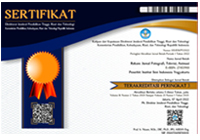Degradasi Estetika dalam Tren Video Vertikal di Platform Digital: Studi Kasus Konten Instagram Reels dan Youtube Short
Abstract
Popularitas video vertikal yang kian melejit sebagai perwujudan era konten digital dalam gengaman tangan (gawai) justru memiliki andil besar pada degradasi nilai-nilai estetika karya sinematografis. Kemunculan platform digital seperti Facebook, Snapchat, Instagram, Tiktok, Twitter, dan Youtube shorts memberikan kesempatan bagi siapapun untuk membuat dan mengunggah video kreatif berformat vertikal tanpa batasan. Kondisi demikian memungkinkan siapa saja menjadi kreator video vertikal dan tidak perlu memperdulikan prinsip-prinsip penciptaan karya sinematografis. Sejalan dengan itu, penelitian ini bertujuan untuk menjelaskan rendahnya kualitas video demi pemenuhan kebutuhan konten video vertikal di platform digital. Melalui pendekatan deskriptif kualitatif, observasi, dan dokumentasi dari konten di platform digital Instagram dan Youtube shorts, penelitian ini menghasilkan dua temuan penting. Pertama, karya video vertikal di platform digital telah kehilangan nilai estetika karena tidak mengikuti konsep-konsep sinematografi. Kedua, adanya aspek komersialisasi di platform digital membuat video vertikal menjadi kurang memperhatikan kualitas akibat kejar tayang (trenviral). Oleh karenanya, penelitian ini memberikan pemahaman tentang potensi degradasi nilai estetika pada konten video vertikal. Diperlukan upaya untuk menyatukan kerja sama yang saling menguntungkan antara gagasan dan teknologi terbaru, seperti membahas bagaimana formula penciptaan video vertikal dapat sesuai dalam memenuhi kebutuhan pelaku atau penikmat, sambil tetap memperhatikan nilai estetika.
Degradation Of Aesthetic Value In Vertical Video Trends On Digital Platforms. The growing popularity of vertical videos as the embodiment of the digital content era in the palm of our hands has contributed to the degradation of the aesthetic values of cinematographic works. The emergence of digital platforms such as Facebook, Snapchat, Instagram, TikTok, Twitter, and YouTube shorts provide opportunities for anyone to create and upload creative videos in vertical format without restrictions. This condition allows anyone to become a vertical video creator and does not need to care about the principles of creating cinematographic works. In line with this, this research aims to explain the low quality of videos to fulfil the needs of vertical video content on digital platforms. Through a descriptive qualitative approach, observation, and documentation of content on the digital platforms Instagram and YouTube shorts, this research produces two important findings. First, vertical video works on digital platforms have lost their aesthetic value because they do not follow cinematographic concepts. Secondly, the commercialization aspect of digital platforms has caused vertical videos to lose their quality due to airtime (trenviral). Therefore, this research provides insight into the potential degradation of aesthetic value in vertical video content. Efforts are needed to bring together mutually beneficial cooperation between ideas and the latest technology, such as discussing how the formula for creating vertical videos can be suitable for the audience.
Keywords
Full Text:
PDFReferences
Agou, S. H. (2020). Comparison of digital and paper assessment of smile aesthetics perception. Journal of International Society of Preventive and Community Dentistry. https://doi.org/10.4103/jispcd.JISPCD_323_20
Bramantyo, T. (2021). Digital Art and the Future of Traditional Arts. Music Scholarship / Problemy Muzykal’noj Nauki, 1, 96–110. https://doi.org/10.33779/2587-6341.2021.1.096-110
Canella, G. (2018). Video Goes Vertical: Local News Videographers Discuss the Problems and Potential of Vertical Video. Electronic News. https://doi.org/10.1177/1931243117705417
Clayton, R. (2019). Filmmaking Theory for Vertical Video Production. The European Conference on Media, Communication & Film. www.iafor.org
Hananto, B. A. (2019). Quick Look at Vertical Music Videos’ Past and Future. IMOVICCON Conference Proceeding. https://doi.org/10.37312/imoviccon.v1i1.10
Laughter, M. R., Anderson, J. B., Maymone, M. B. C., & Kroumpouzos, G. (2023). Psychology of aesthetics: Beauty, social media, and body dysmorphic disorder. Clinics in Dermatology. https://doi.org/10.1016/j.clindermatol.2023.03.002
Liu, W., & Tao, F. (2022). Art Definition and Accelerated Experience: Temporal Dimension of AI Artworks. Philosophies. https://doi.org/10.3390/philosophies7060127
Menotti, G. (2019). Discursos em torno dos vídeos verticais: a arqueologia de uma proporção “errada” de tela. ARS (São Paulo), 17(35), 147–165. https://doi.org/10.11606/issn.2178-0447.ars.2019.140526
Mustikawati, R., Sadewa, G. P., & Fadholi, M. A. (2023). Vertical Video Trends Among Amateur Digital Platform Users as an Alternative for Film Production. Journal of Urban Society’s Arts. https://doi.org/10.24821/jousa.v9i2.7949
Neal, D., & Ross, M. (2018). Mobile framing: Vertical videos from user-generated content to corporate marketing. In Mobile Story Making in an Age of Smartphones. https://doi.org/10.1007/978-3-319-76795-6_15
Pungkiawan, P. R. (2022). Film Dokumenter Potret Rhythm Of Saman. Rekam, 18(1), 59–66. https://doi.org/10.24821/rekam.v18i1.4886
Setiyoko, N. (2022). Batik Pacitan: Kontinuitas dan Perubahannya. Jurnal Kajian Seni. https://doi.org/10.22146/jksks.73000
Sichach, M. (2023). Designing Effective Short-Vertical Videos on Tik Tok and Reels for Civic Education on Misinformation, Disinformation, and Misinformation (MDM) on Social Media Platforms in the age of Artificial Intelligence. SSRN Electronic Journal. https://doi.org/10.2139/ssrn.4468598
Simonova, S. A., & Averyushkin, A. N. (2022). TO THE QUESTION OF THE AESTHETICIZATION OF MODERN CULTURE. Izvestiya of the Samara Science Centre of the Russian Academy of Sciences. Social, Humanitarian, Medicobiological Sciences. https://doi.org/10.37313/2413-9645-2022-24-85-73-77
Sudarmanto, J. A. (2023). The Evolution of Vertical Video: TikTok and the 21st Century Children’s Interactive Learning Trend. Education and Human Development Journal. https://doi.org/10.33086/ehdj.v8i1.3576
Sugiyono. (2019). Metode Penelitian Kuantitatif Kualitatif dan R&D. Alfabeta.
Suprihono, A. E. (2019). Sinematografi Wayang: Persoalan Transmedia Seni Pertunjukan Tradisional dalam Program Tayangan Televisi. REKAM, 15(2), 137–152. https://doi.org/10.24821/rekam.v15i2.3355
Vizcaíno-Verdú, A., Contreras-Pulido, P., & Guzmán-Franco, M. D. (2021). Youtube musicians and self-perceived multimedia, hypermedia, intertextual and transmedia competencies. Learning, Media and Technology. https://doi.org/10.1080/17439884.2021.1941099
We Are Social. (2022). Hootsuite (We Are Social) Digital 2022: Indonesia. In Datareportal.Com.
Želinský, D., Smith, P., & Simonsen, S. (2022). From artistic consecration to degradation: The case of Sven Hassel. Acta Sociologica (United Kingdom). https://doi.org/10.1177/00016993211022792
Zhu, H., Zhou, Y., Yao, R., Wang, G., & Yang, Y. (2022). Learning image aesthetic subjectivity from attribute-aware relational reasoning network. Pattern Recognition Letters. https://doi.org/10.1016/j.patrec.2022.02.008
Zhu, T., Zhang, D., Hu, Y., Wang, T., Jiang, X., Zhu, J., & Li, J. (2022). Horizontal-to-Vertical Video Conversion. IEEE Transactions on Multimedia. https://doi.org/10.1109/TMM.2021.3092202
DOI: https://doi.org/10.24821/rekam.v21i1.13423
Refbacks
- There are currently no refbacks.

This work is licensed under a Creative Commons Attribution 4.0 International License.




